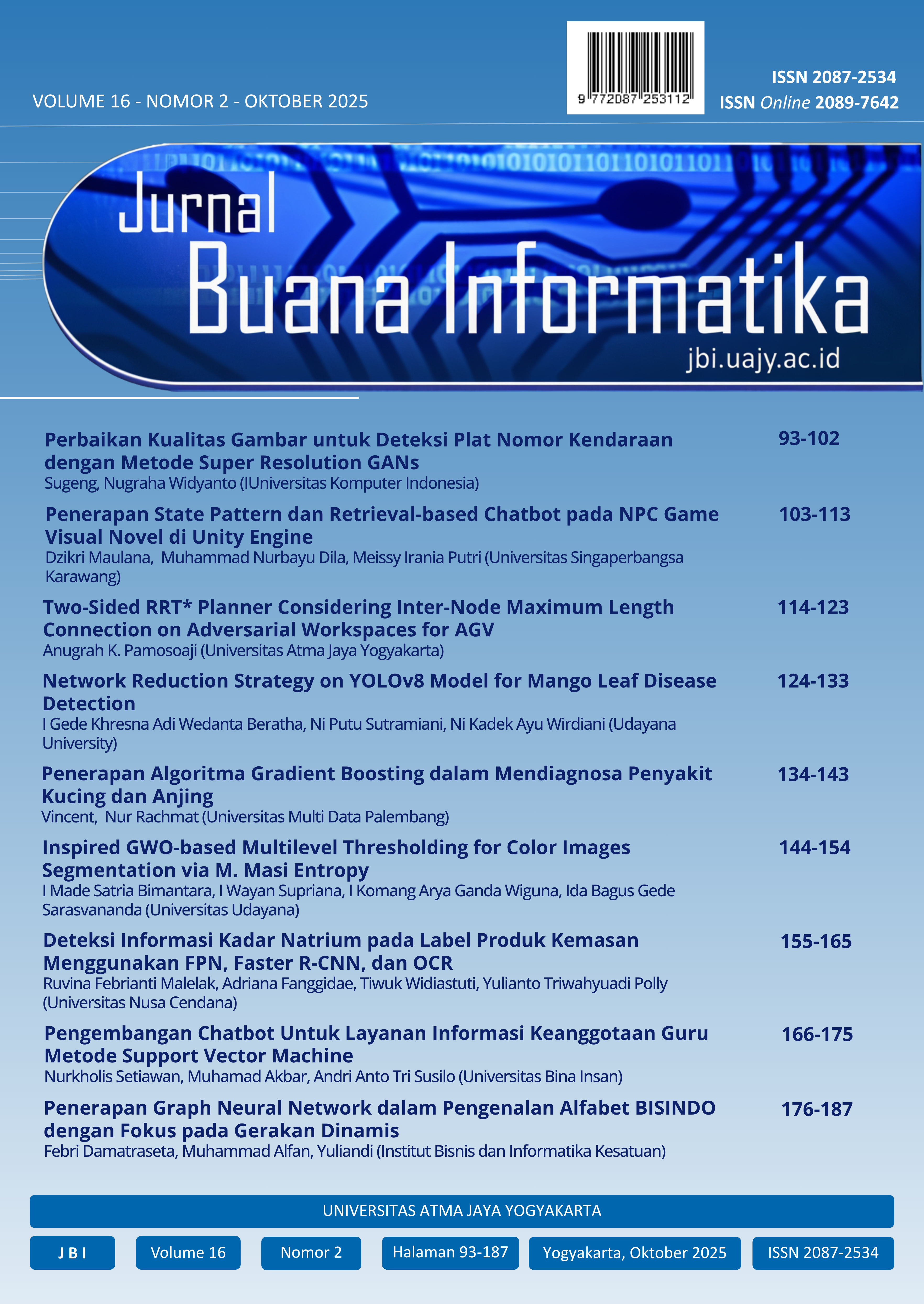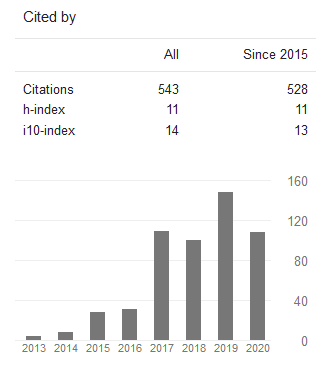Two-Sided RRT* Planner Considering Inter-Node Maximum Length Connection on Adversarial Workspaces for AGV
Keywords:
Automated guided vehicle (AGV), perencanaan jalur, rapidly explored random tree (RRT), Algoritma A*, path planning, A* algorithmAbstract
This paper presents a two-sided Rapidly-Explored Random Tree (RRT*) which is a variant of RRT* path planning algorithm that utilizes a start and a target node as the bases for generating paths. The advantage of this method is in the capability to make a connection between start and target nodes under adversarial workspace. In this type of workspaces, the main problem in RRT* is the success rate of constructing a complete and optimized route and reducing path-generation processing time. The proposed algorithm is purposed to increase the route generation success rate and reduce the processing time. The technique consists of two-fold: the application of maximum length of inter-node path and two-sided node generation, i.e., from the start and target nodes. Simulation results conclude that the application of large maximum length of inter-node path can increase the success rate of complete route construction.
References
W. Zhu and G. Qiu, “Path Planning of Intelligent Mobile Robots with an Improved RRT Algorithm”, Applied Sciences, vol. 15, no. 6, 3370, 2025. DOI: 10.3390/app15063370.
M. Duan, Z. Wang, X. Shao, and G. Ren, “VGA*-RRT*: A Mobile Robot Path Planning Algorithm for Irregular and Complex Maps”, IEEE Access, vol. 13, 2025. DOI:10.1109/ACCESS.2025.3552785.
H. Yang, X. Luo, C. Duan, P. Wang, K. Zhu, X. Deng, and W. Ren, “Research on Multi-Objective Point Path Planning for Mobile Inspection Robot Based on Multi-Informed-Rapidly Exploring Random Tree”, Engineering Applications of Artificial Intelligence, vol. 151, no. 110645, pp. 1-21, 2025. DOI:10.1016/j.engappai.2025.110645
C. Zhao, Y. Zhu, Y. Du, F. Liao, and C.-Y. Chan, “A Novel Direct Trajectory Planning Approach Based on Generative Adversarial Networks and Rapidly-Exploring Random Tree”, IEEE Transactions on Intelligent Transportation Systems, vol. 23, no. 10, pp. 17910-17921, 2022. DOI:10.1109/TITS.2022.3164391.
E. Aydemir and M. Unel, “Motion Planning and Path Following for Autonomous Navigation and Reversing of a Full-Scale Mining Truck and Trailer System”, International Journal of Automotive Technology, vol. 26, no. 3, pp. 595-606, 2025. DOI:10.1007/s12239-024-00174-9.
B. Z. Türkkol, N. Altuntas, and S. Ç. Yavuz, “A Smooth Global Path Planning Method for Unmanned Surface Vehicles Using A Novel Combination of Rapidly Exploring Random Tree and Bézier Curves”, Sensors, vol. 24, no. 8145, pp. 1-17, 2024. DOI:10.3390/s24248145.
X. Li, J. Yang, X. Wang, L. Fu, and S.Li, “Adaptive Step RRT*-Based Method for Path Planning of Tea-Picking Robotic Arm”, Sensors, vol. 24, no. 7759, pp. 1-22, 2024. DOI:10.3390/s24237759.
C. Urrea, P. Sari, J. Kern, and H. Torres, “Enhancing Adaptability and Autonomy in Cooperative Selective Compliance Assembly Robot Arm Robots: Implementation of Coordination and Rapidly Exploring Random Tree Algorithms for Safe and Efficient Manipulation Tasks”, Applied Sciences, vol. 14, no. 6804, pp. 1-28, 2024. DOI:10.3390/app14156804.
T. Xu, J. Ma, P. Qin, and Q. Hu, “An Improved RRT* Algorithm Based on Adaptive Informed Sample Strategy for Coastal Ship Path Planning”, Ocean Engineering, vol. 333, no. 121511, pp. 1-17, 2025. DOI:10.1016/j.oceaneng.2025.121511.
H. Zhong, Y. Du., D. Liu, M. Wang, M. Cong, and X. Tian, “A Fruit Fly-Inspired Path Planning Algorithm for Unmanned Aerial Vehicle in Underground Environments Based on Low-Discrepancy Sequences”, Engineering Applications of Artificial Intelligence, vol. 156, no. 111250, pp. 1-15, 2025. DOI: 10.1016/j.engappai.2025.111250.
X. Xu, P. Li, J. Zhou, and W. Deng, “Path Planning for Quadrupedal Robot Based on Improved RRT-Connect Algorithm”, Sensors, vol. 25, no. 8., pp. 1-18, 2025. DOI:10.3390/s25082558.
C. Liu, F. Xiao, Y. Ma, H. Chen, Y. Wu, Z. Li, and L. Guo, “An Enhanced RRT* Algorithm with Biased Sampling and Dynamic Stepsize Strategy for Ship Route Path Planning in the High-Risk Areas”, Ocean Engineering, vol 332, no. 121 466, pp. 1-11, 2025. DOI:10.1016/j.oceaneng.2025.121466.
Z. Liu, M. Li, R. Zhang, G. Zhang, S. Han, and K. Chen, “Preoperative Path Planning of Craniotomy Surgical Robot Based on Improved MDP-LQR-RRT* Algorithm”, Biomedical Signal Processing and Control, vol. 105, no. 107647, pp. 1-16, 2025. DOI:10.1016/j.bspc.2025.107647.
P. Upadhyay and R. Singh, “Advanced Hybrid Path Planning: Integrated Modified IRRT* with Bezier Curve Enhancements”, Robotic Intelligence and Automation, vol. 45, no. 3, pp. 434-462, 2025. DOI:10.1108/RIA-12-2024-0285.
Downloads
Published
Issue
Section
License

This work is licensed under a Creative Commons Attribution-ShareAlike 4.0 International License.
Copyright of this journal is assigned to Jurnal Buana Informatika as the journal publisher by the knowledge of author, whilst the moral right of the publication belongs to author. Every printed and electronic publications are open access for educational purposes, research, and library. The editorial board is not responsible for copyright violation to the other than them aims mentioned before. The reproduction of any part of this journal (printed or online) will be allowed only with a written permission from Jurnal Buana Informatika.
This work is licensed under a Creative Commons Attribution-ShareAlike 4.0 International License.










